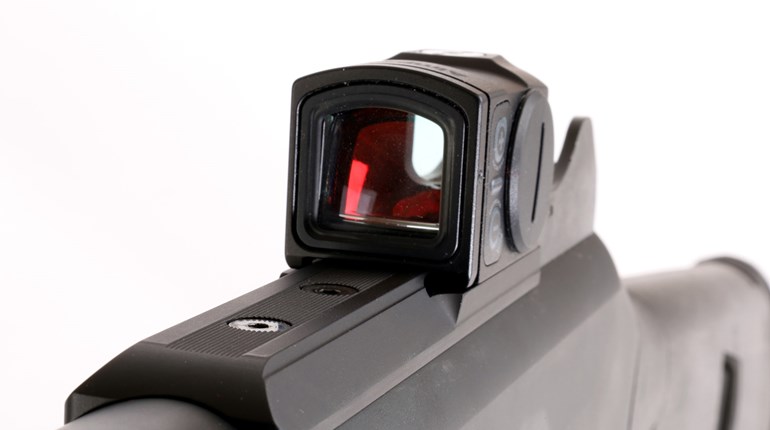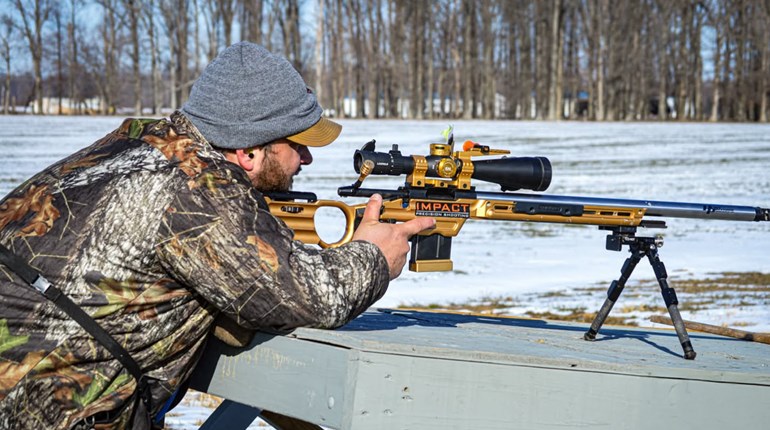
Aimpoint Micro T-2
Aimpoint needs precious little introduction to most “First Gear”readers (though we have plenty of references here, if you like). Basically, the company is at the pinnacle of the reflex, or “red-dot,” sight world.
A quick refresher: This is a class of non-magnifying optics that uses a small, bright and very efficient light source to overlay an aiming point on a target. In addition to being long-lived in the battery sense (like, years?), they bring a couple of other advantages to aiming: The dot appears on the same visual plane as the target, meaning your distance correction—if you have one—puts both target and aiming point in clear, precise focus. Also, that aiming point does not require precise “centering” in the field of view—if the dot is on your intended target, initiate. It doesn’t matter where it’s up or down, left or right in the “view” of the scope tube: You’re still on target.
The result, and particularly in the case of Aimpoint “Micro” versions, is the speed and versatility they bring to a host of aiming tasks. At 3.3 ounces, they add miniscule mass to nearly any firearm, yet with practice will give very satisfying results at astonishing distances. The 2 MOA dot will leave a lot of target unobscured at 300 meters and more. If you’re up to it, the Aimpoint certainly is.The 2 MOA dot will leave a lot of target unobscured at 300 meters and more. If you’re up to it, the Aimpoint certainly is.
Two things we like particularly about the T2 (and which means you’re liable to read more about it soon elsewhere): A new lens design and coatings make the dot even better than it was before, and by this we mean more uniform. We hate to repeat it, but to appreciate this properly, remember to use that distance prescription.
Oddly, the other thing we liked best isn’t optical per se, and not really new—the LRP mount. For us, this system has been on five different rails now, with firearms ranging from .22LR up to 7.52x51. A camming, self-locking lever combines with a blade driver or wrench-adjustable tension screw to make this about the best attachment system we know of. Low profile, it won’t hamper other manipulations, yet it was rock-solid everywhere, and return-to-zero issues never appeared within the limits of our trials.
Just in case you really want a little magnification along with all the benefits of the Aimpoint Micro T-2, consider this (from our recent trip to SHOT).
Visit Aimpoint at http://www.aimpoint.com/. MSRP of the Micro T-2 is $846.
Sierra 90 grain .355 JHP
There is tremendous satisfaction in finding a firearm that really suits you, though it can be a tricky proposition. Often, the difficulty in finding the size, model and caliber that matches up with individual ergonomics and an intended purpose is resolved only by old-fashioned trial and error. That’s a nuisance for sure, and sometimes an expensive one.

Another round of trial and error often awaits, too: Particularly with handguns, ammunition variation is a second wilderness of seeming contradictions. Even ammunition of a single caliber that is identically labeled often performs with very noticeable differences over time. In the end, it’s no wonder that we Americans—inveterate tinkerers that we famously are—are such avid handloaders.
Balanced against the upfront costs and an ongoing commitment to learning the process well and safely is a grail of sorts: You’ll gain surprisingly complete control of how a given firearm performs, and will be able to reliably reproduce the ammunition that makes that possible.
All of which gets us to a little Sierra 9 mm bullet, #8100 by designation. It’s a 90-grain jacketed hollow point that runs against our normal tastes: As a rule, we prefer heavier bullets for their ability to reduce felt recoil when matched up with appropriate powders (and spring rates in auto-loaders). We’ve found, however, that this very light 9 mm (or .380 ACP) bullet is an impressive performer in several contexts, including apparent softening of recoil.
In handguns, and particularly in dual recoil spring designs, the recommended charges of medium and faster powders get the bullet down the barrel—and the actions of these pistols cycling—in a hurry. A little math tells the tale: Energy is very similar to 115-grain “ball” (@1,200 ft./sec., 368 ft.-lbs.) when the 8100 is driven at 1,371 ft./sec. (375 ft.-lbs.), yet recoil is more than 10 percent lighter (using “power factor” as our comparison metric). This load was based on a fairly “fluffy” powder that filled the case well, and generated only 19 ft./sec. gross velocity variation (8 ft./sec. S.D.) in our Glock G-17 test pistol. We found it accurate and disproportionately pleasant-shooting. (Full disclosure here: We detest the 115 as a general rule. Like most middleweight bullets in most calibers, it makes things understandably simpler for manufacturers, but produces neither comfortable recoil nor the best performance along several other parameters.)

We also had a lot of fun with the Sierra in a couple of 9 mm carbines (JP and Lone Wolf). The identical load jumped up well over 1,600 ft./sec. (547 ft.-lbs.), and proved quite accurate, despite a considerable accuracy-reducing “coast” in the last half-to-third length of the over-long barrels that non-NFA 9 mm carbines have. A dueling tree at 100 yards is cheap, ridiculous fun, but will demand good trigger work.
A last thought from our teaching sessions: For inexperienced shooters, 9 mm can be a little jarring, especially in the 115-grain varieties. This can make good grip architecture and mechanics harder to instill, and lead to anticipation-sourced limp-wristing (being soft on the second “P”). With the little Sierra, we found the apparent shortening of the recoil impulse very helpful in getting some students over this hump and eliminating the accompanying malfunctions.
We don’t think we’ve rat-holed quite all of these—not for want of trying—but our advice would be unchanged: If you find some Sierra 8100s, buy ’em.
Visit Sierra at http://www.sierrabullets.com/. We found #8100s in stock at Brownells and Midway. Prices vary around $17/100.


































